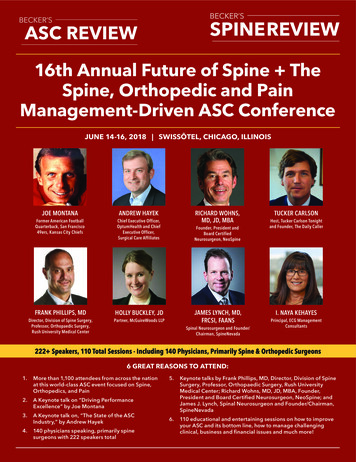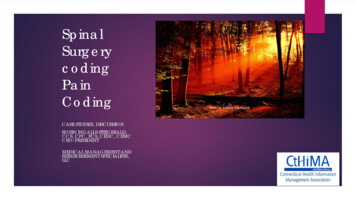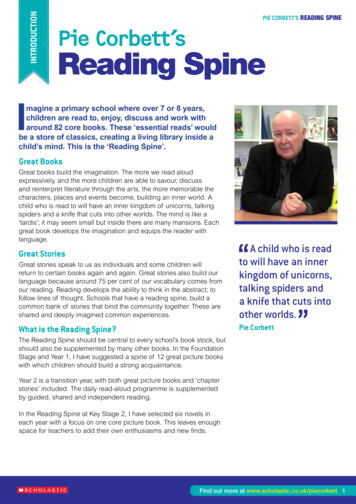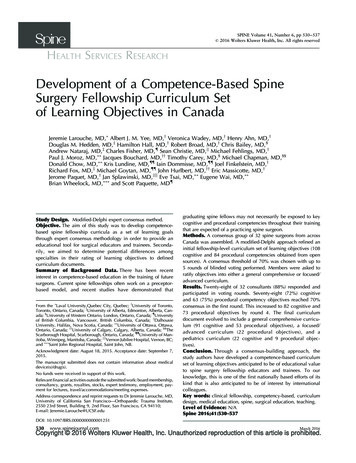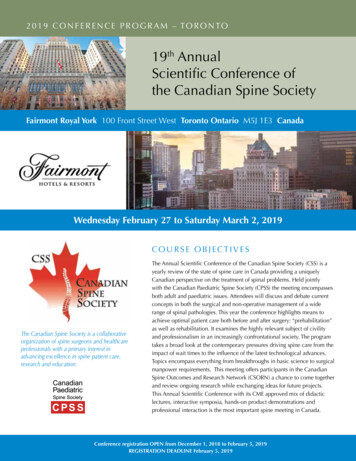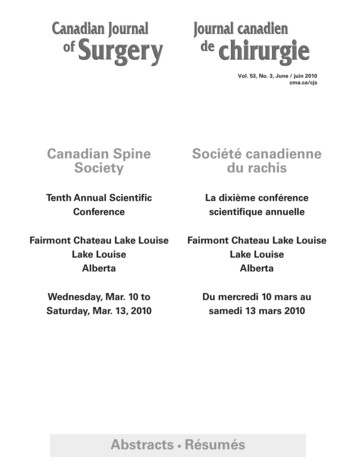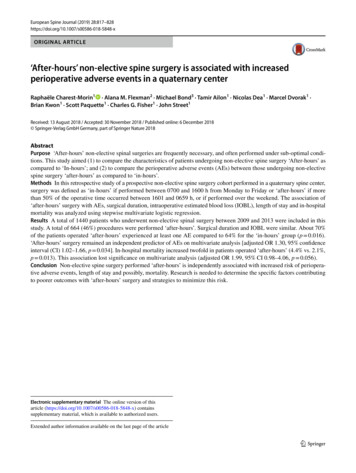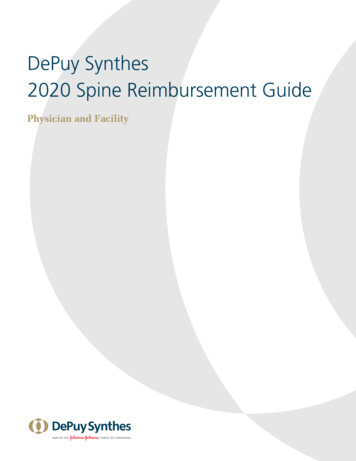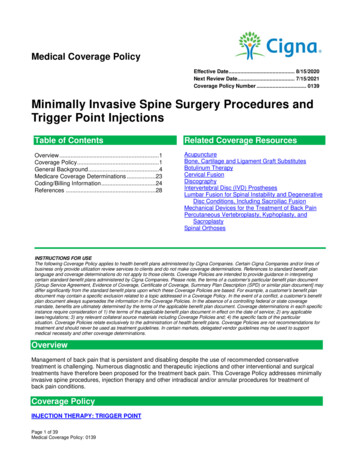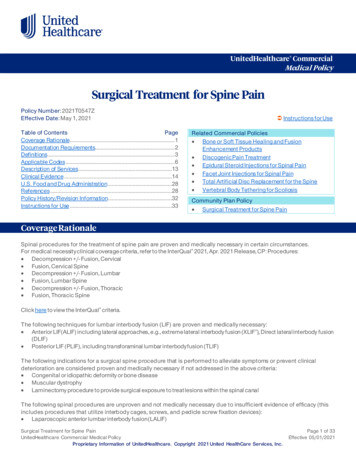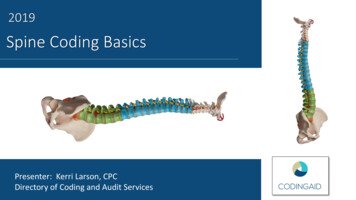
Transcription
2019Spine Coding BasicsPresenter: Kerri Larson, CPCDirectory of Coding and Audit Services
2019 Spine Surgery0102030405Spine Surgery Terminology & AnatomySpine ProceduresCase StudyDiagnosisQ&A
Spine Surgery Terminology & Anatomy
Spine Surgery Terminology & AnatomyTermArthrodesisDefinitionFusion, or permanent joining, of a joint, or point of union of two musculoskeletal structures, such as two bonesBone graftingSurgical procedure that replaces missing bone with material from the patient's own body, or from an artificial, synthetic, ornatural substituteCorpectomySurgical excision of the main body of a vertebra, one of the interlocking bones of the back.Cerebrospinalfluid or CSFDecompressionDiskectomy,discectomyDuraThe protective body fluid present in the dura, the membrane covering the brain and spinal cordA procedure to remove pressure on a structure.Surgical removal of all or a part of an intervertebral disc.Outermost of the three layers that surround the brain and spinal cord.Electrode array Device that contains multiple plates or electrodes.Electronic pulseA device that produces low voltage electrical pulses, with a regular or intermittent waveform, that creates a mild tingling orgenerator ormassaging sensation that stimulates the nerve pathwaysneurostimulator
Spine Surgery Terminology & AnatomyTermDefinitionEpidural spaceExtraduralFacetThe space that surrounds the dura, which is the outermost layer of membrane that surrounds the spinal canal. The epidural space houses thespinal nerve roots, blood and lymphatic vessels, and fatty tissues .Present inside the skull but outside the dura mater, which is the thick, outermost membrane covering the brain or within the spine but outsidethe dural sac enclosing the spinal cord, nerve roots and spinal fluid.Smooth area on a boneA round, flat, fibrous tissue layer between two adjacent vertebrae, the interlocking bones of the spine, consisting of a tough outer layerIntervertebral disc (anulus fibrosus) and a jellylike central part (nucleus pulposus) that acts as a flexible cushion between the vertebrae to aid in load bearing andshock absorptionIntraduralIntramedullaryLaminaWithin the dura, the tough outer membrane surrounding the central nervous system.Within the deep part of a structure, such as in the bone marrow. Subarachnoid space: The space between the pia mater, the inner most layerof the meninges that surround the brain and the spinal cord, and the arachnoid mater, the middle layer of the meninges .A part of a vertebral arch that covers the back surface of the spinal canal, forming a protective roof over the spinal cord.Lateral extracavitary A surgical approach to the spine, incising along the middle of the back and then turning sharply toward one side to follow the generalapproachdirection of the ribs of the patient; the incision resembles an L and is often referred to as a hockey stick incision.LesionArea of damaged or diseased tissue, particularly an area that is well–defined.
Spine Surgery Terminology & AnatomyTermDefinitionNerve rootThe portion of a nerve where it connects to the central nervous system, i.e., the brain or spinal cord; the origin of a nerve.OsteotomyThe cutting of bone for treatment purposes.Paraspinal muscles The band of muscles that run next to the spine that support and move the spine.PedicleSpinal cordStereotacticradiosurgeryA paired part of the vertebral arch, the posterior part of a vertebra, that connects a lamina to the vertebral body.Group of nerve fibers encased in the vertebral column that connects the brain to the rest of the bodyA noninvasive neurosurgical discipline that uses ionized radiation to destroy target areas.Subarachnoid spaceThe space between the pia mater, the inner most layer of the meninges that surround the brain and the spinal cord, and the arachnoid mater,the middle layer of the meninges.VertebraeThe bony segments that form the spine and protect the spinal cord; there are 33 segments divided into five different levels — the neck(cervical spine, C1 through C7), upper and middle back (thoracic spine, T1 through T12), lower back (lumbar, L1 through L5), sacral (sacrum, S1through S5), and tail bone (coccyx which consists of 4 fused bones).
Spine Surgery Terminology & Anatomy
Spine Surgery Terminology & Anatomy
Spine Procedures
Spine ProceduresTHE FOUR ELEMENT OF SPINE PROCEDURE CODINGWhy: The Diagnosis; the reason for the surgery. Primary DiagnosisHow: How are you getting there, whatapproach? Main ApproachWhere: Where is the anatomical location? Main LocationWhat: What is it that you are doing? Main Procedure
Spine ProceduresNeoplasm-New or abnormal growth of tissue(iemalignant tumors)Lesion-Any Pathological or traumatic discontinuity oftissue or loss of function of a part.Deformity-A permanent structural deviation from thenormal shape or sizeSpinal Condition-Spine related condition (e.g. stenosis,disc herniation, spondylosis)
Spine ProceduresSPINAL ANATOMY
Spine ProceduresVERTEBRAL SEGMENT VS VERTEBRAL INTERSPACEVertebral SegmentCPT defines the Vertebral Segment as the basic constituent part into which the spine may be divided. It represents a singlecomplete vertebral bone with its associated articular processes and laminae.Vertebral InterspaceCPT defines the Vertebral Interspace as the non-bony compartment between two adjacent vertebral bodies, which containsthe intervertebral disc, and includes the nucleus pulposus, annulus fibrosus, and two cartilaginous endplates.
Spine ProceduresExample: The Surgeon may be doing work in theVertebral Space.Each of the CPT descriptors identifies the typeof anatomical component involved in the code.Vertebral Interspaces are identified with a “-”i.e.: C3-C4, C4-C5 for interspaces for discectomies.Vertebral Segments are identified with a “,”i.e.: C3, C4, C5 for segments of corpectomies.
Spine ProceduresAnother Example:The vertebral interspace is denoted with “-” (the pink locations)i.e. T3-T4, T4-T5 for interspaces for discectomiesThe vertebral segment is denoted with “,”i.e.: T3, T4, T5 for segments of corpectomies (the green locations)
Spine ProceduresANATOMY TO KNOW
Spine Procedures Know the approachWhere your Surgeon is making the incision is where you start your coding. If your Surgeon has an Anterior Incision (front of the body), start with an Anterior Code If your Surgeon has a Posterior Incision (back of the body), start with a Posterior CodeFor example: Anterior interbody fusion is not possible through a posterior approach.
Spine ProceduresMAIN APPROACH
Spine ProceduresAnterior Approach ProceduresThere are 4 main types of Anterior Approaches. Thisinformation is key because they are clearly indicatedin each specific type of CPT Code. Anterior/Lateral Transthoracic Thoracolumbar Retroperitoneal
Spine ProceduresAnterior ArthrodesisCPTs 22548 – 22586Basic Description Also known as a “Fusion” Procedure Can be performed for indications such as herniated disc; degenerative, traumatic, and/or congenital lesions; or to stabilizefractures or dislocations of the spine CPT choices are separated by the different levels of the spine (Cervical, Thoracic, and Lumbar) Patient is placed in the Supine Position (face up) An incision is made over the targeted vertebra and dissected down to the interspace The physician cleans out the intervertebral disc space, removing the cartilaginous material above and below the vertebrato be fused Preparation includes discectomy and osteophytectomy for nerve root or spinal cord decompression. Application of instrumentation and Bone Graft may be applied to the interspace. Heads Up: In addition to choosing your Arthrodesis CPT, there are additional potential charges to account for.
Spine ProceduresConsider these 2 components when Coding an Anterior Arthrodesis Procedure1)Was Instrumentation applied(screws)? If so, the instrumentation can be billed separately.o See CPTS 22845 – 22848, 22853 - 22859o The CPT is chosen by the number of Vertebral Segments receiving instrumentation.o Only one anterior instrumentation CPT code may be reported through a single skin incision.2) Was Bone Graft Applied? If so, the Graft Material can be reported separately.o See CPTs 20930 – 20938o There are 2 different types of Bone Graft that can be appliedo Auto Graft Bone fragments taken from the patient’s own vertebral bodies adjacent to the affected disc, from thespinous process, or laminar fragment.o Allograft Pieces of donor or synthetic bone graft materialo When choosing your Graft CPT, you’ll also need to confirm if the graft was:o Morselized Small Pieces of Bone Grafto Structural Larger Piece of Bone Graft to fill in bony defects
Spine ProceduresIn regard to Instrumentation:NCCI Policy states:CPT codes 22853 and 22854 describe insertion of interbody biomechanical device(s) into intervertebral discspace(s). Integral anterior instrumentation to anchor the device to the intervertebral disc space when performedis not separately reportable. It is a misuse of anterior instrumentation CPT codes (e.g., 22845-22847) to reportthis integral anterior instrumentation. However, additional anterior instrumentation (i.e., plate, rod) unrelated toanchoring the device may be reported separately appending an NCCI-associated modifier such as modifier 59.
Spine ProceduresCorpectomy ProceduresCPTs 63300 – 63308Basic Description: Procedure is performed to remove an intraspinal lesion in the extradural or intradural space of the spinal canal Select these codes according to location (cervical, thoracic, or lumbar/sacral), approach (anterior/anterolateral, transthoracic,thoracolumbar, transperitoneal, or retroperitoneal) and whether the surgeon cuts into the dura (the fibrous membrane that formsthe outer covering of the central nervous system). If the surgeon cuts into the dura, it is an "intradural" procedure; if not, it'sextradural. Anterior or Anterolateral Procedure –Patient is placed in Supine Position(face up) Transverse incision or right vertical incision is made in the lateral neck. Physician resects the vertebral body and the intraspinal lesion is excised by the physician.CPT GuidelineFor vertebral corpectomy, the term partial is used to describe removal of a substantial portion of the body of the vertebra. In thecervical spine, the amount of bone removed is defined as at least one-half of the vertebral body. In the thoracic and lumbar spine, theamount of bone removed is defined as at least one-third of the vertebral body.
Spine ProceduresWhen we apply our Codes we’ll see that each one of the 4 have adifferent representation based on the sub approach that’s indicated inthe CPT Code. Anterior/Lateral 63300 Transthoracic63301 Thoracolumbar63302 Retroperitoneal63303 NOTE: The type of approach matters. If you can’t determine theapproach in the Op-note, query your Provider to confirm where theystarted.
Spine ProceduresINSTRUMENTATION GUIDELINES
Spine ProceduresINSTRUMENTATION GUIDELINESInstrumentation is Coded by “construct” type and notably bythe number or levels or interspaces involved, along with theanatomical placement of the instrumentation.We need to know exactly where the instrumentation wasplaced in order to make the appropriate CPT choices(becausewe are counting levels and interspaces).
Spine ProceduresINSTRUMENTATION GUIDELINESNon-segmental Instrumentation: Posterior: 22840Segmental Instrumentation: Posterior: 22842-22844Anterior Instrumentation: Anterior: 22845-22847Spinous Process Wiring: Posterior: 22841Pelvic Instrumentation Posterior: 22848Biomechanical Devices: Anterior/Posterior: 22853 - 22854, 22859
Spine ProceduresINSTRUMENTATION GUIDELINESBiomechanical Implants Codes: 22853-22854-22859 When coding Biomechanical Implants it is important to identify: The interspace where the implants were placed.not the number of implants placed The type of anterior instrumentation that is used when it involves Biomechanical Devices. If the instrumentation has an integrated system or an integrated component, it’s important for us toknow in order to select the proper code-set. It is important to bill for all of the instrumentation for the case. This includes Anterior, Posterior, Lateral, etc.,but we need make sure that we have the supportive documentation in the body of our op note in order for usto code each individual construct.
Spine ProceduresINSTRUMENTATION GUIDELINESInstrumentation Reinsertion and Removal ProceduresCPTs 22849 – 22852, 22855 Code 22849 should not be reported in conjunction with 22850, 22852, 22855 for the samespinal levels Only the appropriate insertion code (22840 -22848) should be reported when previouslyplaced instrumentation is being removed or revised during the same operative session wherenew instrumentation is inserted at levels including all or part of the previously instrumentedsegments Do not report the reinsertion code (22849) or removal (22850, 22852, 22855) procedures inaddition to insertion of new instrumentation (22840-22848)
Spine ProceduresINSTRUMENTATION GUIDELINES22853, 22854 and 22859 may be reported more than once for non contiguous defects Cages placed at different levelsDo not append modifier 62 to spinal instrumentation codes: 22840-22848, 22850, 22852, 22853, 22854, 22859For application of an intervertebral bone devise/graft, see 20930, 20931, 20936, 20937, 20938 Allograft cages 20931
Spine ProceduresINSTRUMENTATION
Spine ProceduresGRAFTING PROCEDURES Grafting is used quite often in Spine Coding,especially when choices coding cases involvingFusion. There are different types grafting and boneproducts used for grafting. New products hit themarket just about everyday! When coding, we have choices in Spine Coding thatwe can look to when coding for grafts. Autograft vs. Allograft Structural vs. Non-Structural Same-site, separate incision, bone products.As Coders, we need the Surgeon to account for allprocedures performed. We will then decide whichcodes will be selected based on the documentation. Spine specific graft codes are in the 20930-20939
Spine ProceduresGRAFT TERMINOLOGY Cadaver: Body of deceased person. Allograft: A tissue graft harvested from one person foranother; donors include cadavers and living individualsrelated or unrelated to the recipient; also called allogeneicgraft and homograft. Morselize: To break into very small pieces, or morsels. Autograft: A tissue graft harvested from another locationin the patient’s own body. En bloc: French term for all together or as a whole. Osteopromotive: Substance that encourages new bonegrowth. Structural allograft: A single piece of bone for grafting thatprovides direct support for skeletal structures. Bone shaver: Surgical instrument used to remove a verythin slice of bone. Localize: To identify a specific area of interest. Osteotome: Surgical instrument used to cut bone.
Spine ProceduresThere are 3 types of Posterior Approach. Posterior Lateral Transpedicular Costovertebral
Spine ProceduresPosterior, Posterolateral, Lateral Transverse ArthrodesisCPTs 22590 – 22819Basic Description Also known as a “Fusion” Procedure Can be performed for indications such as herniated disc; degenerative, traumatic, and/or congenital lesions; or to stabilizefractures or dislocations of the spine CPT choices are separated by the different levels of the spine (Cervical, Thoracic, and Lumbar) Patient is placed in the Prone Position (face down) An incision is made over the targeted vertebra and dissected down to the vertebra A chisel elevator is used to strip away the capsules of the lateral articulations, and the articular cartilage and cortical bone isexcised. Application of Instrumentation and Bone Graft are placed for stabilization TIPS: Do not report 22612 with 22630 for the same interspace and vertebral segment, see 22633. Heads Up: In addition to choosing your Arthrodesis CPT, report any instrumentation and grafts CPTs separately.
Spine ProceduresLateral Extracavitary ArthrodesisCPTs 22532 - 22534Basic Description Also known as a “Fusion” Procedure CPT choices are separated by the different levels of the spine (Thoracic or Lumbar) Posterior Procedure - Patient is placed in the Prone Position (face down) An incision is made over the targeted vertebra and dissected down to the vertebra The Provider removes the associated transverse process, lateral portion of the facet, and pedicle Removes the degenerated disk material from the space, scrapes the cartilage from the vertebral end plates Application of instrumentation and Bone Graft may be applied to the interspace. Heads Up: In addition to choosing your Arthrodesis CPT, there are additional potential charges to account for. Was Instrumentation applied(screws, plates)? If so, the instrumentation can be billed separately.o See CPTS 22840 – 22841, 22853 – 22859 Was Bone Graft Applied? If so, the Graft Material can be reported separately.o See CPTs 20930 – 20938
Spine ProceduresLateral Extracavitary Approach for Extradural Exploration/DecompressionCPTs 63101 - 63103Basic Description Also known as a “L.E.C.A.” Procedure CPT choices are separated by the different levels of the spine (Thoracic or Lumbar) Posterior Procedure An incision is made over the targeted vertebra and dissected down to the vertebra the Provider removes part of or an entirethoracic vertebral bone and intervertebral disc materialCPT GuidelineFor vertebral corpectomy, the term partial is used to describe removal of a substantial portion of the body of the vertebra. Inthe cervical spine, the amount of bone removed is defined as at least one-half of the vertebral body. In the thoracic andlumbar spine, the amount of bone removed is defined as at least one-third of the vertebral body.
Spine ProceduresDECOMPRESSIONSCoding is based on the interspace and levels anddegree of decompression and are diagnosis based. Always start with your diagnosis when codingDecompressions as the Decompression CPT choiceis totally directed by the diagnosis. There are several types of Decompressions that canbe performed during the surgical session.Decompressions can be performed in a wide range ofProcedures, below are Cervical procedures w/Decompression to name a few.Laminotomy: 63020, 63040Laminectomy: 63001, 63015, 63045, 63265, 63275Corpectomy/Vertebrectomy:63081, 63300, 63304Laminoplasty: 63050, 63051
Spine ProceduresDecompressions with Posterior Lumbar Interbody Fusions Decompressive procedures may be combined with lumbar interbody fusion procedures in some cases. The need for the decompression must be identified by the diagnosis(medical necessity) and supported byclearly reporting the decompressive procedure in the op note. The op-note must demonstrate the need for the decompression, the actual work involved in thedecompression and the results, including the actual spinal elements decompressed(what nerve roots weredecompressed). Note- This does not reflect the position of all carriers. CMS does not permit submission of thedecompression at the same level of the interbody fusion. Note- The documentation must support a full and complete decompressive procedure in order to codeindependently.
Spine ProceduresBUNDLING EDITS
Spine ProceduresEXPLORATION OF FUSION DOCUMENTATIONCPT 22830-Exploration of spinal fusionThere is much debate whether this procedure should becoded when another Fusion is performed.In order to code for this procedure we have to make surethat the Surgeon has documented all of the work involved inthe exploration and that the exploration has beencompleted. Detail of the levels involved, the findings and themedical decision making process should all be listed in theop-note. Note- CMS does not allow an exploration of Fusionand Refusion at the same levels. While coding your Op-note be sure to confirm that theSurgeon has described
2019 Spine Surgery. Spine Surgery Terminology & Anatomy Spine Procedures Case Study. 01 02 03 04. Diagnosis. 05. Q & A
